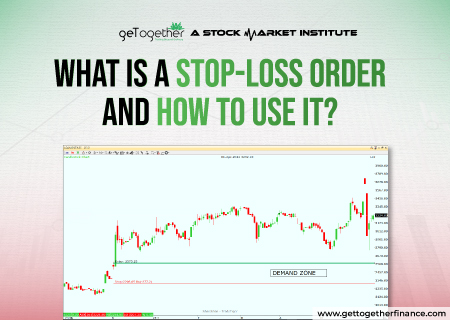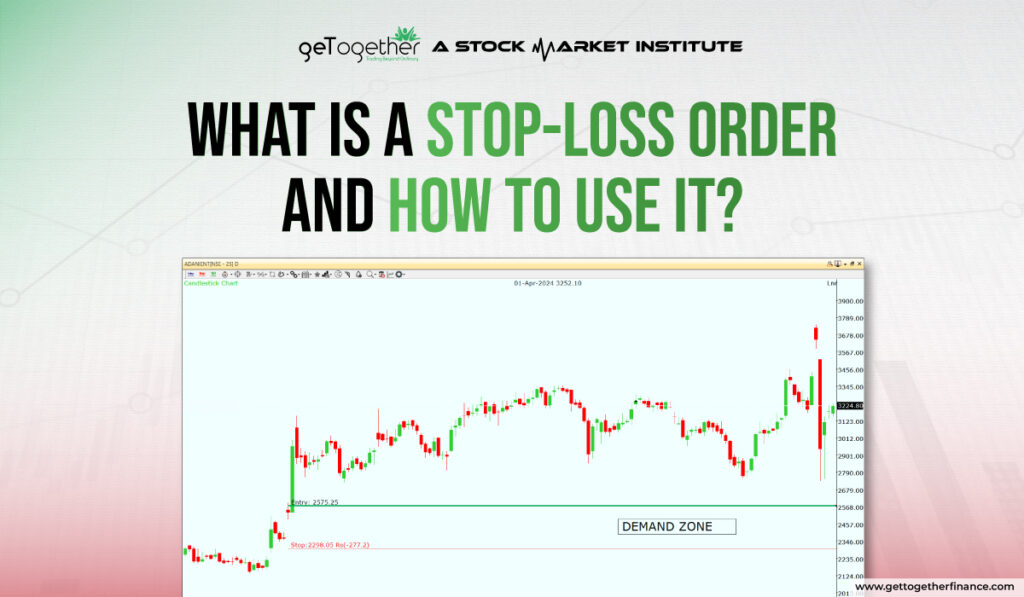What is a Stop-Loss Order and How To Use It?


Introduction
It’s never the risk that will lead you towards trouble, instead, it’s the non-calculative risk that will. Taking risks is part of stock market trading, but people get deceptive between risks and calculative risks. It’s the calculative risk that goes a long way. One should know how much they are willing to risk for a certain amount of profit. That is where stop-loss orders are used.
A Stop-loss order is a tool used by traders to limit their losses in the trade. It automatically sells the stocks if it goes beyond a certain price level, to limit the exorbitant losses. The traders can pre-set it based on their analysis.
Stop-loss orders are equally important as targets, targets give you desired profits, whereas, stop-loss orders save you from potential losses. By setting a realistic stop-loss order, traders can control the risks involved in their trade and avoid emotional decisions during market volatility.
Understanding Stop-Loss Orders

A stop-loss order is a pre-set order where the stock or security is automatically sold or bought if the price goes in an unfavorable direction. It is to limit the potential losses in every trade. Stop loss order is placed in both long and short positions. In long positions, the sell order is placed to limit the losses from a certain price level whereas in short orders buying orders are placed in case the price unexpectedly starts going up.
How Stop-Loss Orders Work
When you set a stop-loss order you set the price level at which you want the order to be executed if the price of security or stock goes in an unfavorable direction. Let’s understand this with an example if you buy a stock at ₹50 and set the target for ₹80, but if the stock doesn’t go in a favorable direction you set the stop loss at ₹40 to limit your losses further. Here, the stock will be automatically sold if the price drops to ₹40. This helps protect you from further declines, limiting your loss to ₹10 per share.
Types of Stop Loss Orders
There are two main types of stop-loss orders: Fixed and Trailing.
Fixed Stop-Loss Orders
As the name suggests, a fixed stop loss order is a set order which does not change. Understanding it from the previous example, the stop-loss is firmly set at ₹40. Irrespective of the type of move that comes in the stock, the stop-loss remains at ₹40, offering a non-negotiable way to manage risks.
Trailing Stop-Loss Orders
A trailing stop-loss order is dynamic and changes according to market conditions. Traders can adjust stop-loss orders as the price of stock or security moves in their favor. Let’s understand this with the above example, if you bought the stock at ₹50 and it started going up, giving you gains. Then you place your stop loss order on higher price levels, to get the minimum gains. If the price of the stock has gone up to ₹65, then instead of booking profits right away, you can place a stop loss order at ₹60, if the price faces a sudden drop, then you get the gain till ₹60, that is rs 10 per share. If the price continues to go up, then you can trail your stop loss to the nearest price levels managing your gains,
To summarize, stop-loss orders are critical instruments for risk management in trading, as they automatically limit potential losses and protect your investment.
Where to Place a Stop Loss Order

Stop loss and target go hand in hand. The strategy you’re using needs to be strong enough to give you realistic stop loss and target orders.
Supposedly if you’re using demand and supply theory combined with price action, then you can take the entry from the marked demand zone and support area and set the target based on the supply zone or resistance area.
Now for the stop loss order, you can place it from where the trade surpasses your trade setup in an unfavorable direction. Referring to the above example, you can place it on the price level where the demand zone or support area breaks, meaning that your trade setup has failed and the price might not go down from this level.
For all the other strategies, you can place the stop-loss order at the price levels where your trade setup fails. It will simply imply that the price may not go up from your anticipated levels, it’s better to book losses at an early level in this scenario.
Why Should I Place a Stop Loss Order?

Placing a stop loss at ideal price levels is necessary to limit the losses in volatile and unfavorable market conditions. Here’s how it helps:
- It helps in protecting your capital by automated selling on the predetermined levels. This not only protects you from hefty losses but also protects your mental breakdown that traders get during the volatile market and end up panic selling, losing the majority of their capital.
- Placing stop-loss orders is as necessary as having a target in the trade, it makes you a rule-based and disciplined trader. It ensures that you stick to your risk management strategy irrespective of market conditions; you need to have confidence in your analysis but also know that nobody can be 100% correct in the market.
- When your active trades are safeguarded by stop loss order, you get to focus on analyzing the market with a relaxed mind rather than panicking by seeing the sudden loss on the trades.
- Trailing stop loss comes as an excellent benefit to booking the maximum possible profit. Leveraging the opportunity to place stop loss to the nearest price elves and enjoying the upward rally helps traders enjoy good profits.
- Placing a stop loss at ideal levels makes you prepared for the amount of loss you’re gonna get if the trade doesn’t go in a favorable direction. Hence, you’re not mentally taken aback by the loss.
Overall, stop-loss orders are a simple and effective technique to protect your portfolio, reduce possible losses, and maintain a balanced approach to trading.
Online Brokers and Stop Loss

Online brokers have made trading easier and more accessible for all. There are several online brokers that give you the option of placing a stop loss order at the limit you want while placing the order. While buying the stock at a certain price, you can select the option for a stop loss order and place a stop loss at the same time, making it easier for you.
Also, online brokers are also giving you the option of stop loss trailing, which gives you a hassle-free trading experience, without worrying about missing the right price levels. In stop loss trailing, the trade automatically executes if the downtrend starts.
Here are some online brokers that are known for giving hassle-free trading experience with easy stop loss and stop loss trailing orders:
- Dhan Trading app
- Sharekhan
Common Mistakes to Avoid

Setting stop loss too near: Setting your stop loss order very near to the entry price can lead to an increased number of stop loss trades because the sudden market fluctuations make it easier to catch the nearest price levels. It reduces the chances of potential gains.
Setting stop loss too far: Setting the stop-loss very far from the entry price can increase the potential losses, because then you let the price travel too much to the downside, keeping your capital at higher risk.
Consider Market Volatility: Whenever you’re entering into the trade, consider and study the extent of market volatility well. Know whether to place the nearest stop loss or have a wider gap between entry and stop loss level based on the market condition to safeguard your capital.
Do not consider them sole saviors: Do not depend on your stop-loss orders without having comprehensive risk management strategies. Use them as a component in your trading plan; plan your trades well with good entry, and exit points, capital positioning, and diversification.
Fixed orders don’t work always: You need to have a dynamic understanding of the market and adjust your stop loss order whenever needed, it helps in not missing out on potential market opportunities.
Emotional Trading: Never let emotions influence your decisions for placing and adjusting stop loss orders, it may get you swayed by market volatility leading to hefty losses.
Also Read: Zerodha Margin Calculator
Conclusion
Stop-loss orders are critical instruments for risk management and asset protection in trading. When prices hit predefined levels, they automatically sell or acquire securities, allowing traders to avoid big losses and make more disciplined decisions. Whether you use fixed or trailing stop-loss orders, these tactics can help you avoid emotional trading and provide piece of mind amid market turbulence. They guarantee that traders adhere to their risk management strategies, protect their capital, and are able to focus on analyzing fresh opportunities. Leveraging stop-loss orders, particularly with enhanced capabilities offered by online brokers, can improve trading efficiency and profitability. To summarize, stop-loss orders are a simple yet effective strategy to maintain a balanced and strategic approach to trading.
FAQs
What is a stop-loss order?
A stop-loss order allows a broker to automatically sell or buy a security or stock when its price hits a specified level, thereby limiting potential losses in trading.
How do stop-loss orders work?
When you place a stop-loss order, you define the price at which the order will be executed if the market goes negatively. If you buy a stock for ₹50 and set a stop-loss at ₹40, it will be instantly sold if the price falls to ₹40, limiting your loss to ₹10 per share.
What is the difference between fixed and trailing stop loss orders?
A fixed stop-loss order remains at a predetermined price level, independent of market change. A trailing stop-loss order responds dynamically to favorable price movements, locking in profits while guarding against large losses.
Why should I use stop stop-loss order?
Using a stop-loss order protects your capital by automatically limiting losses during volatile market circumstances. It also encourages disciplined trading, inhibits emotional decision-making, and lets you concentrate on analyzing fresh chances rather than fretting about active deals.
How can I set stop stop-loss order?
Many online brokers allow you to set stop-loss orders, both fixed and trailing. This feature is included into their trading systems, providing a seamless and hassle-free trading experience. Some well-known brokers that provide these capabilities are Dhan Trading app, Sharekhan, and Zerodha.



 Instagram
Instagram 
